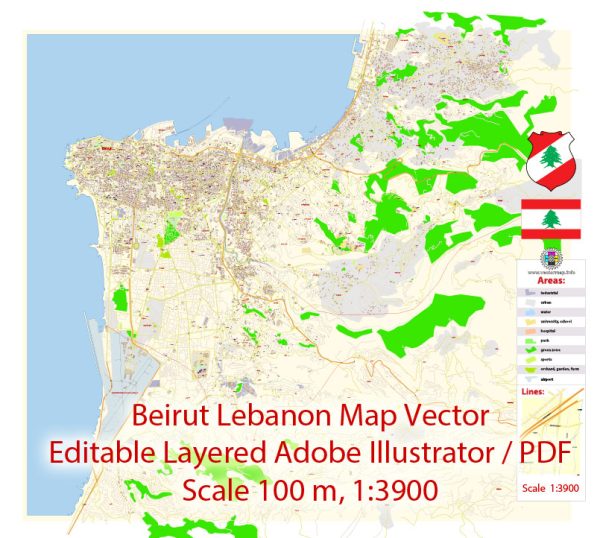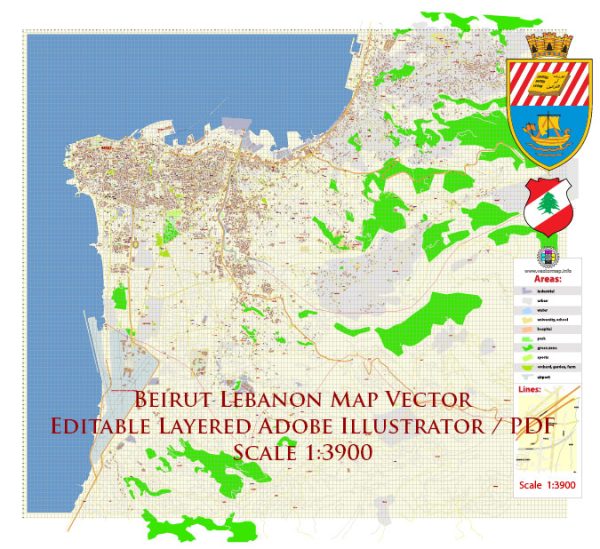Beirut, the capital and largest city of Lebanon, is a vibrant and historically rich urban center with a diverse mix of cultures, religions, and architectural styles. Here’s a description of some urban amenities in Beirut:
- Cultural Heritage:
- Historic Sites: Beirut is home to various historical landmarks, including the Roman Baths, the Pigeon Rocks, and the iconic Raouché area.
- National Museum of Beirut: A treasure trove of artifacts that showcase Lebanon’s rich history, from prehistoric times to the Ottoman era.
- Shopping and Entertainment:
- Souks: Beirut is known for its lively markets, such as the Souk el Tayeb and the Souk el Ahad, where visitors can explore local crafts, spices, and more.
- Malls: Modern shopping centers like Beirut Souks and ABC Mall offer a wide range of international and local brands.
- Dining and Nightlife:
- Restaurants: Beirut boasts a diverse culinary scene, with restaurants offering Lebanese, Mediterranean, and international cuisine. Gemmayze and Mar Mikhael are popular areas for dining out.
- Nightclubs and Bars: Beirut has a vibrant nightlife with numerous bars and clubs, especially in the trendy areas of Gemmayze and Monot Street.
- Green Spaces:
- Sanayeh Garden: A central park in Beirut, providing a peaceful escape from the urban hustle with walking paths and greenery.
- Horsh Beirut: A larger park where residents can enjoy nature, have picnics, and engage in outdoor activities.
- Education:
- Universities: Beirut is home to prestigious universities such as the American University of Beirut (AUB) and the Lebanese American University (LAU).
- Schools: The city has a variety of international and local schools, offering quality education.
- Healthcare:
- Hospitals: Beirut has well-equipped hospitals and medical centers, including the American University of Beirut Medical Center (AUBMC) and Saint George Hospital University Medical Center.
- Transportation:
- Public Transport: Beirut has a public bus system, and shared taxis, known as “service” or “servees,” are commonly used for short distances.
- Rafic Hariri International Airport: Located near the city, the airport connects Beirut to international destinations.
- Art and Culture:
- Galleries and Theaters: Beirut has a thriving art scene with numerous galleries and theaters, such as the Beirut Art Center and the Al-Madina Theatre.
- Cinemas: Movie enthusiasts can enjoy the latest films in modern cinemas around the city.
- Beaches:
- Beirut’s Coastline: The city is situated along the Mediterranean Sea, and public and private beaches along the coast provide opportunities for relaxation and water activities.
- Residential Areas:
- Achrafieh and Hamra: These neighborhoods offer a mix of residential and commercial spaces, with a blend of modern and traditional architecture.
- Downtown Beirut: The reconstructed downtown area is known for upscale living, with luxury apartments, hotels, and high-end shops.
Beirut’s urban amenities reflect its dynamic character, combining modernity with a rich cultural and historical backdrop. Despite facing challenges, the city continues to be a hub of creativity, resilience, and diverse experiences.



 Author: Kirill Shrayber, Ph.D.
Author: Kirill Shrayber, Ph.D.